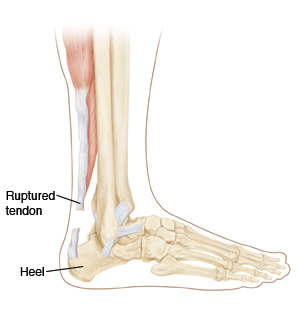Achilles Tendon Rupture, Partial or Complete

The Achilles tendon connects the muscles in the back of your lower leg to your heel bone. It lets you point your foot down. This is called a “step on the gas pedal” motion. This movement is important for walking, running, and jumping. A sudden strong contraction of the lower leg can partially tear (rupture) the Achilles tendon. This injury can happen while playing sports. This injury is more likely if you have injured the tendon in the past. It is also more likely if the tendon is inflamed from stress.
When the injury happens, you may feel a pop or snap, or like you have been kicked. An Achilles tendon tear will cause swelling, bruising, and pain in the ankle area. You will have trouble walking or pushing off the ground with your foot.
A complete Achilles tear is often treated with surgery to attach the torn ends of the tendon. This is followed by up to 12 weeks in a walking cast, boot, or splint. The injury can also be treated without surgery, but the tendon will take longer to heal. The risk of rupturing it again is also greater than with surgery. With either type of treatment, you may need physical therapy to strengthen your Achilles tendon. It often takes up to 6 months to return to your past level of activity. And it takes about 1 year to fully recover.
Home care
Medicine
Your healthcare provider may prescribe medicines for pain. Or you may use acetaminophen or Ibuprofen to control the pain. Talk with your provider before taking these medicines if you have chronic liver or kidney disease. Also talk with your provider if you have had an ulcer or gastrointestinal bleeding.
General care
-
Rest. Use crutches as directed. Don't put any weight on the injured leg until your healthcare provider says it is OK. You will be told to see an orthopedic doctor as soon as possible. This is a doctor with special training to treat bone and muscle problems.
-
Use ice. Put a cold pack on the injured area for 20 minutes at a time. Do this at least 4 to 8 times a day for the first 48 hours. After the first 48 hours, use the cold pack to ease pain and swelling, as needed. You can make your own cold pack from a sealed bag of frozen peas or ice. Wrap the bag in a towel. Don’t put the cold source directly on your skin. (If you are using ice, be careful to avoid getting the cast wet as the ice melts.) If you have a splint that can't be removed, put the cold pack over the splint.
-
Use compression. The healthcare provider may give you an elastic wrap, boot, air cast, or splint to help ease swelling. Use this as the provider tells you to.
-
Elevate your leg. During the first 48 hours, keep your injured leg elevated on a pillow when you are sitting or lying down. The pillow should be at a level above your heart. This is very important to reduce swelling.
-
Keep the splint or cast dry. When bathing, protect it with a large plastic bag. Make sure to tape the plastic bag closed, or use rubber bands. If a fiberglass splint or cast gets wet, you can dry it with a hair dryer.
Follow-up care
You will be referred to an orthopedic doctor for follow-up care. Surgery may be needed to repair this injury, so it is very important to make an appointment with the specialist as soon as you can.
When to get medical advice
Call your healthcare provider right away if any of these occur:
-
A plaster splint or cast gets wet or soft or breaks
-
A fiberglass splint or cast gets wet and doesn't dry in 24 hours
-
Pain or swelling gets worse, or redness appears
-
Toes or the injured area become cold, blue, numb, or tingly
-
You can't put weight on the injured leg after being told to do so